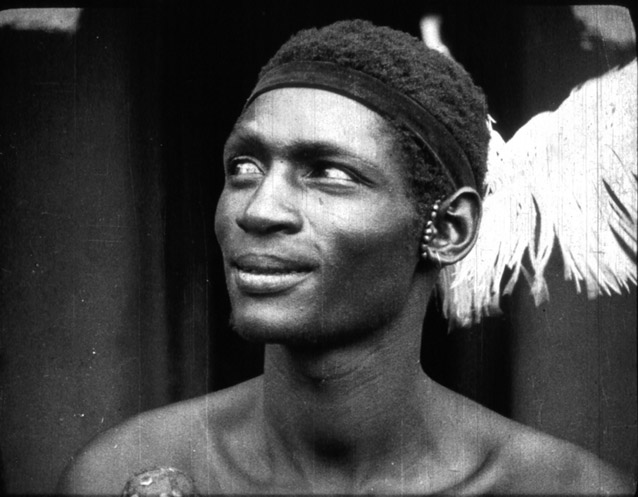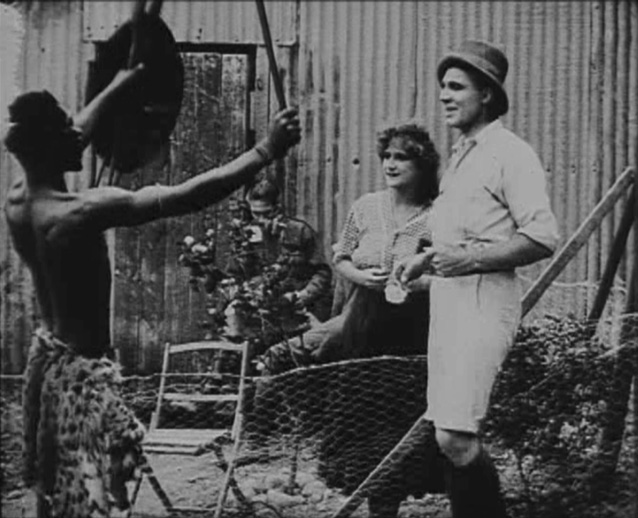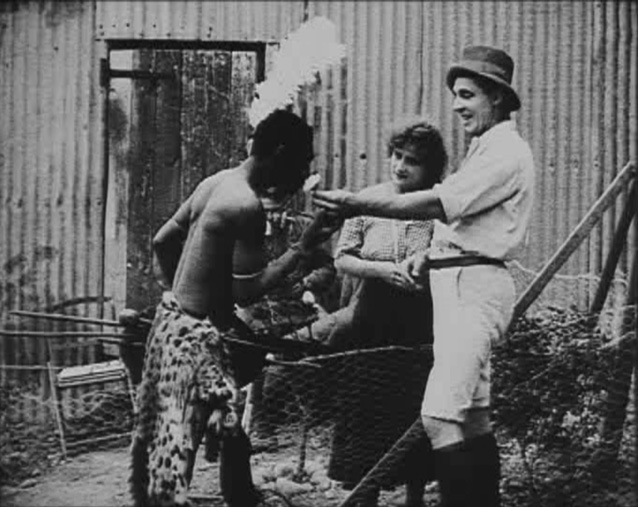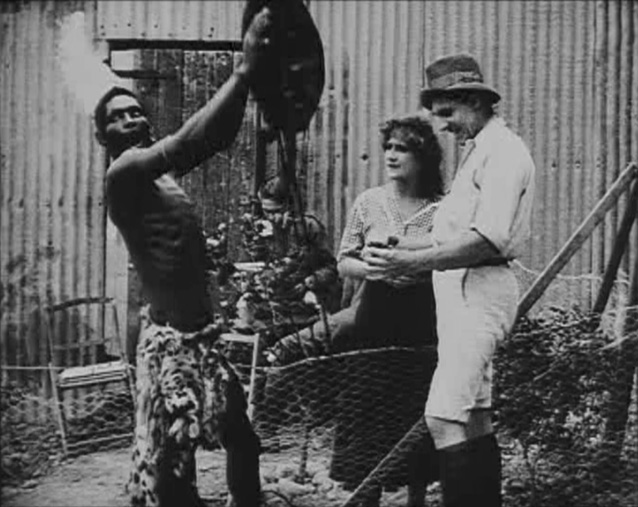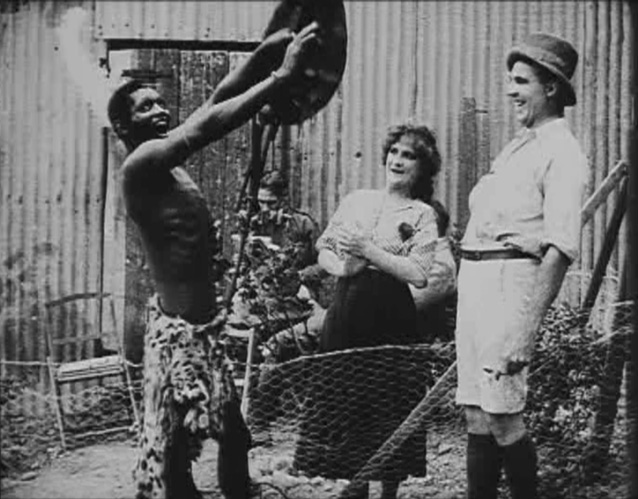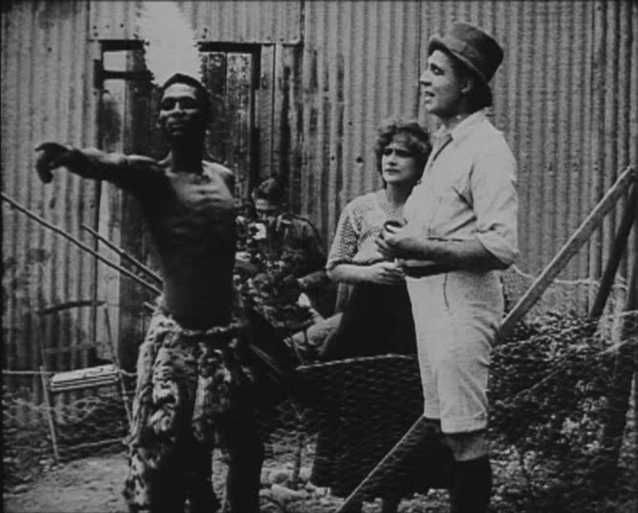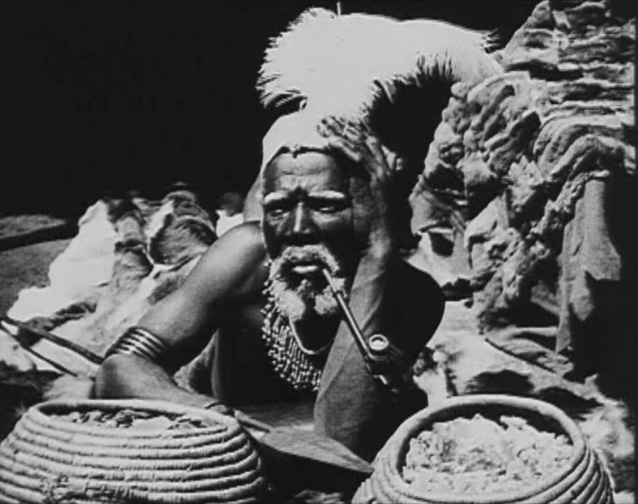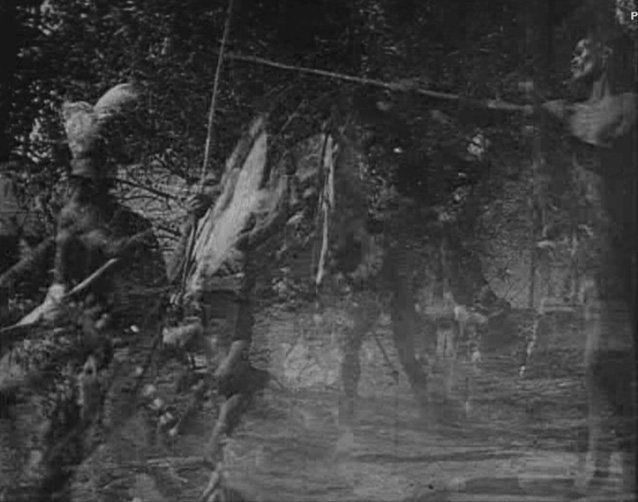Abstract
In this essay I discuss the racial discourse underlying the regulation of space, actor movement, and gesture in The Rose of Rhodesia (1918), whose animation and restraint of black characters, by communicating a message of interracial brotherhood and reconciliation, appear to address real-life tensions between colonial masters and subjects. Shaw’s film is inflected by local as well as global discourses on race and imperialism, and scholars have noted that his South African productions—first and foremost in De Voortrekkers / Winning a Continent(1916)—were stylistically influenced by D. W. Griffith’s epic The Birth of a Nation (1915). My discussion initially focuses upon the similar, yet subtly different, racial thematics of these melodramas, which I situate in two contexts: the regulatory aspects of Sub-Saharan film production; and what I call an imperial ethics of care, a global discourse on race linked to the late-Victorian British media. I then examine the striking way in which the principal black actor, Yumi, appears to have been directed to use a histrionic mode of acting which had been largely abandoned by Hollywood directors. This return to what Roberta E. Pearson has dubbed the “eloquent gestures” of film melodrama, I argue, can be related to two linked problems for white settlers: the supposed inability of Africans to comprehend cinema; and the risk of black insurgency. In directing his African actors to use an antiquated, histrionic style comprised of unambiguous poses and extravagantly courteous gestures, Shaw sought to fix the film’s meaning for black and white audiences alike.
……….
Many film scholars have argued that media representations of empire played a critical role in building and maintaining colonial rule by fleshing out, interlinking, and negotiating complex power relationships between the white colonial imagination and the material practices of colonists and subjects.[1] The narrative aesthetics of The Rose of Rhodesia (1918), a feature film directed by the Hollywood-trained Harold Shaw in South Africa in late 1917 and early 1918, present a valuable case in point, offering as they do a pedagogical, imperative story of peaceful fraternity between white masters and royal black subjects.
In the following essay I will discuss the racial discourse underlying the regulation of space, actor movement, and gesture in the film, whose animation and restraint of black characters, by communicating a message of interracial brotherhood and reconciliation, apparently address real-life tensions between colonial masters and subjects. As such, I will argue, Shaw’s film is inflected by local as well as global discourses on race and imperialism. Scholars have already noted that Harold Shaw’s South African productions—first and foremost in De Voortrekkers / Winning a Continent (1916)—were stylistically influenced by D. W. Griffith’s epic The Birth of a Nation (1915), a film variously celebrated as “writing history in lightning” and denigrated as racist propaganda (Maingard 2007, 19). Pursuing Shaw’s connection to “the father of film” (Williams 2001, 26, 109), my discussion will initially focus on the similar, yet subtly different, racial thematics of these melodramas, which will be situated in two contexts: the regulatory aspects of Sub-Saharan film production; and what I will be calling an imperial ethics of care, a global discourse on race with its origins in the British media.
My analysis of The Rose of Rhodesia has its point of departure in one of the film’s most striking features: a histrionic mode of acting. Used in films until the early 1910s, histrionic acting involved the coding of emotions in a highly stylized repertoire of bodily and gestural expressions (see Pearson 1992). It was gradually replaced by a verisimilar acting mode which sought instead to communicate emotions by means of more subdued and discursively “realistic” gestures. In The Rose of Rhodesia, the main exemplar of the histrionic style is the principal black character, Mofti, played by “Prince” Yumi, whose acting appears to have been modelled on a style which had by this point been largely abandoned by Hollywood directors. Yumi appears to have been heavily coached by Shaw to perform an image of primitive “Africanness” by means of an antique acting style. This return to what Roberta E. Pearson has dubbed the “eloquent gestures” of earlier feature films can, in turn, be related to two linked problems for white settlers: the supposed inability of Africans to comprehend cinema; and the risk of black insurgency. In directing his African actors to use an antiquated, histrionic style comprised of unambiguous poses and extravagant gestures, Shaw sought to fix the film’s meaning for black and white audiences alike.
From Interracial Struggle to an Ethics of Care
One of the few surviving examples of early South African film, The Rose of Rhodesia was made during a period when British rule in sub-Saharan Africa was recurrently contested by black opposition. Before turning to the film itself, therefore, I wish to recapitulate briefly the scholarship on the contemporary imperial context. Shaw, who started his film career as an actor in the early 1900s, came from Kentucky to Hollywood. In 1916, while acting and directing for the London Film Company in the British capital, he was hired by Isidore W. Schlesinger, the ascendant media mogul of the Sub-Saharan region, to make films in South Africa for his newly-founded African Film Productions (AFP). Shaw’s first production for AFP, De Voortrekkers / Winning a Continent (1916) was a hugely popular, albeit controversial, historical epic about the mythologized Battle of Blood River, at which Boer settlers had defeated a Zulu army in the Transvaal in 1838.
De Voortrekkers tapped into a founding myth behind Afrikaner attempts to form a free republic. Gustav Preller, the Afrikaner movement’s local spokesman and Shaw’s main liaison person, turned De Voortrekkers into a rhetorical instrument for shaping white Boer identity, notably by promoting official recognition of the Boer language, Afrikaans (see Maingard 2007, 16-34). Indeed, as Jacqueline Maingard notes, its split-screen intertitles (Fig. 6.1) were the first to represent Afrikaans in that medium. During production, the Department of Native Affairs strongly opposed Shaw’s plans to re-enact the Battle of Blood River “on the grounds of the undesirability of any activities calculated to bring black and white … into even mimic armed conflict” (quoted in Maingard 2007, 27). Despite reassurances that black extras would be armed with “especially designed collapsible assegais [spears],” the scene turned into something dangerously close to real combat after it emerged that some Boer extras had secretly brought rounds of live ammunition instead of blanks:
At a subsequent magisterial enquiry it transpired that there had been “a plot to incite and irritate the natives” …. The “Boers” had shot at the “Zulus” as they charged the laager [circled waggons], and Shaw had tried to stop it, but the “Boers” had continued firing at close range even when they were withdrawing …. [Peter] Davis puts an interesting slant on this “story.” This “Second Battle of Blood River” … is in fact a battle between the descendants of those who had fought the first battle almost 80 years previously. Thus, the re-enactment of the battle was more “real” for both parties than would necessarily have been supposed. (Maingard 2007, 27)
By contrast, De Voortrekkers represented the Boers as vulnerable settlers seeking freedom from British imperial domination (in fact, anti-slavery legislation) and their final defeat of the nameless black “natives” as the rightful consequence of Zulu King Dingaan having betrayed and murdered Piet Retief, the leader of the Great Trek, and his party.
Both contemporary reviewers and later film scholars such as Keyan Tomaselli, Peter Davis, and Jane M. Gaines have closely associated De Voortrekkers with The Birth of a Nation. In both films, white aspirations to form a “democratic” nation entail the violent defeat, suppression, and exclusion of blacks. Griffith’s narrative achieves this by rewriting the history of power relationships between black and white southerners during the Reconstruction period in the United States. In the wake of abolitionism and Civil War defeat, the white population in the film is presented as becoming rapidly marginalized and disenfranchised by an unruly and ill-mannered black population which claims full equality as citizens and rushes through new legislation allowing interracial marriage. Throughout the film, African-Americans are depicted as dim-witted, power-hungry, and lusting after white women. At the film’s climax, the two white heroines are threatened with rape, whereupon the putatively ancient order of the Ku Klux Klan is revived and its “knights” restore the divine order by crushing the blacks.
Albeit in different filmic modes, both The Birth of a Nation and De Voortrekkers use narratives of “noble” white mastery in order to mobilize a local discourse of racial authenticity. While De Voortrekkers represent Zulus as a distant mass of shields and spears in sequences that more closely resemble an anthropological film or documentary than feature film footage, the most dramatic moments in The Birth of a Nation’s “historical facsimiles” (Doane 1991, 230) are intimate sexualized encounters between the vulnerable white heroines and the pursuing black rapists (played by white actors in blackface).[2] In Griffith’s film, the racial drama culminates in a chamber play that unfolds in an enclosed space in which Elsie Stoneman cringes in horror upon receiving a marriage proposal from the lecherous “mulatto” Silas Lynch. In an important discussion of the film, Linda Williams emphasizes how literalized the threat of miscegenation is expressed in the scene. Silas, sitting in a chair, insinuatingly thrusts his pelvis forward, rubbing his thighs, while Elsie presses against the locked door, widening her eyes in horror at his gesture (Williams 2001, 123-124). Comparing the racial themes of the two films, Jane M. Gaines notes that where the narrative of De Voortrekkers assumes racial purity, that of The Birth of a Nation strives to assert it (Gaines 2000, 305).
If there is a cinematic affinity between The Birth of a Nation and Voortrekkers, then, it is less a question of stylistic influence—Griffith’s Hollywood in Shaw’s South Africa, so to speak—than of transposing a racial melodrama in which the presence of blacks threatens white innocence. Noting that melodrama has historically served as a privileged narrative mode “in the service of nation-building,” Gaines asks us to consider it as more than simply a genre. “National melodrama,” she writes, “must … be a narrative of lament, a sad song of loss, and yet, simultaneously and contradictorily, it is a hate narrative” (“Birthing Nations,” 2000, 298-9). In a similar strain, Linda Williams claims that, within the peculiarly American “dialectic of racial pathos and antipathy” that characterizes the melodramatic mode, The Birth of a Nation nostalgically represents the antebellum South as a “space of innocence” where slaves and masters lived in harmony (Williams 2001, 100, 119).
In a broader perspective, melodrama has offered a flexible framework for imperialist enterprises by accommodating and enhancing the dream of white supremacy. Edward Said is one of many postcolonial thinkers to evoke the power of a collective white imagination as a vital tool for legitimizing and expanding British imperial conquest: “the enterprise of empire depends upon the idea of having an empire … and all kinds of preparations are made for it within a culture, then in turn imperialism acquires a kind of coherence, a set of experiences and a presence of ruler and ruled alike within the culture” (Said 1994, 10). “Imperium,” he continues, was collectively imagined by the West as a “protracted, almost metaphysical obligation to rule, and subordinate, inferior or less advanced peoples” (Said 1994, 10). Arguing that English imperial identity exceed the boundaries of its material practices, Angelia Poon recalls Thomas Richards’s definition of British imperialism as an overblown form of nationalism that “has gone too far, a nation that has taken over too many countries too far away from home to control them effectively” (Richards 2008, 2). Like Homi Bhabha and Edward Said, Poon sees British imperial identity as vulnerable and ultimately untenable, its centre unable to hold. The feasibility of colonial domination thus depends on constant reiteration of white supremacy through material practices that range from collective ceremonies to individual acts. Although, as Said suggests, the “obligation to rule” required white British subjects to perform the role of a superior race, it should be noted that “performance” here is not a question of voluntary role-playing but, rather, an instance of what Judith Butler has designated performativity: not merely the establishing of relationships through naming but the very “reiterative power” which “produce[s] the phenomena that it regulates and constrains” (Butler, Bodies That Matter, 1993, 2). Poon, in turn, argues that performativity of this kind acquires the semblance of solidity by being “calcified” through “performance reiterated imaginatively at home and throughout the empire” (Poon 2008, 4). I will return to this line of argument in relation to the coding of race in The Rose of Rhodesia.
Whatever the tensions within its romantic narrative of imperial domination, the industrial underpinnings of melodrama point to a more down-to-earth, policing mentality. In order to address both these aspects, I turn, first, to the regulatory dimensions of sub-Saharan film production, and, second, to what I am designating an imperial ethics of care in British media discourse. As James Burns has documented in his history of colonial-era Zimbabwean film, Flickering Shadows (2002), the advent of cinema in sub-Saharan Africa offered British colonizers new ways of consolidating their domination. Although, as Burns notes, film became one of the privileged tools of empire and a potent method of inculcating acceptance of British rule in Africa continent and elsewhere, the cinematic relationship between rulers and ruled was highly inflected by local power dynamics. Similar points have been made by Peter Davis and Priya Jaikumar, who argue that films, though vital for British imperial propagandizing on a large scale, were received very differently around the world. In India, for instance, colonial films were fiercely contested and, like Egypt, was able to develop its own film industry despite censorship by the colonial power (see Jaikumar 2006). Sub-Saharan Africa was a different case: poorer than many other parts of the empire, it suffered under even more inflexible, openly racist forms of rule.
Despite the fact that The Rose of Rhodesia was neither made nor screened in Rhodesia, its racial theme appears to be in dialogue with British censorship discourses in Southern Africa. In Rhodesia, Burns shows, not only was film used as a tool of empire in a general sense, it became a focal point of day-to-day regulating of interracial relations. Almost from its arrival at the turn of the century, he argues, film was seen by British settlers as doubly fraught with danger, and once native Africans began attending screenings, whites grew highly concerned. At the same time as they engaged in discussions of how Africans were “permanently and radically different from … Western man” (Burns 2002, 2-3), settlers worried about whether black audiences were really capable of comprehending motion pictures as a medium. With an eye to simmering black opposition, the white minority was very careful not to incite new rebellion by screening “inappropriate” themes.
The anxiety of Southern Rhodesia’s colonial rulers became increasingly visible in their censorship practices (Burns 2002, 3). Shortly before the outbreak of the First World War, the Rhodesian Criminal Investigations Department covertly sent one of its officers to investigate possible oppositional activities during film screenings. In 1914, after a number of male settlers had gone to fight in the war, the white community’s sense of vulnerability increased and film screenings were scrutinized even more anxiously. White concerns initially revolved around the supposed lewdness of African audiences but the focus of attention soon shifted to the problem of cinematic depictions of black-on-white violence, and, in the late 1910s, measures were taken to bar Africans from all potentially inflammatory scenes (Burns 2002, 5ff). During the following decades, censors in neighbouring South Africa developed a unique eight-point classification system to prevent spectators of colour from seeing images that might incite crime or violence.[3] South African cinema regulations of the 1930s solved the “native problem” by requiring that films be screened according to the following audience categories:
For general exhibition;
For exhibition to Europeans only;
For exhibition to Europeans and non-Europeans (excluding natives);
For exhibition to persons over the age of 12 only;
For exhibition to Europeans and non-Europeans over 12 years of age (excluding all natives);
For exhibition to Europeans and non-Europeans over 16 years of age (excluding all natives);
For exhibition to Europeans over 12 years only;
For exhibition to Europeans over 16 years only. (Harley, The World-Wide Influences of the Cinema, 1940, 180)
While films were certainly in some measure redacted, the censor’s attention was mostly focused on excluding specific audiences.
In its fictional treatment of an impending colonial conflict, The Rose of Rhodesia can thus be seen as an expression of white settler anxiety about how to depict interracial antagonism without inciting it. To be sure, the fateful production of De Voortrekkers the preceding year must have been a vivid memory among the British settler communities. Before discussing the pacifying and fraternal theme of The Rose of Rhodesia, I want briefly to address the variety of ways in which imperial media discourse sought to temper threats of insurgency with expressions of love and care.
In an analysis of Victorian and post-Victorian advertisements for Pears’ Soap and other domestic cleaning products, Anne McClintock has examined the ways in which the British Empire strove to naturalize its hierarchy of racial difference using a lexicon of redemptive hygiene, whiteness, and civilization (McClintock 2000). Pears’ Soap, she shows, acquired alchemizing capacities that promised to modernize, harmonize, (en)lighten, and elevate a global population of brown colonial subjects. McClintock describes a process whereby Pears’ and other soap advertisers conjured up an imperial family of impeccability and virtue, a material discourse which transformed the bar of soap itself into an agent of history possessed of far-reaching reformatory powers. Significantly, these assertions of supremacy, benevolence, and virtues of whiteness, which were widely disseminated in advertising images of harmonious colonial territories and relations, emerged at a time when imperialism was increasingly being questioned in British colonial territories.[4]
The swelling opposition to British imperialism in the early twentieth century was thus being answered by media discourses and commercial advertising which articulated an imperial ethics of care—a softer rhetoric of “the white man’s burden”—in order to “civilize” subject peoples. As McClintock’s examples show, advertising images and mass-produced commodities do not simply reflect or illustrate the dynamics of history, they are central, active components in the process of making meaning: imperialism needed such constant reinscription and moral legitimation of its civilizing mission to rule over populations who vastly outnumbered the white settlers. And, between the 1900s and the 1930s, asserting the benevolence and altruism of imperialism evidently became an increasingly difficult task.
It is only when we juxtapose specific cultural contexts, such as those discussed by Burns, McClintock, and Jaikumar, with early censorship practices more broadly that this rhetorical shift in imperial media discourse becomes fully visible.[5] As Jaikumar points out, the British Empire’s growing vulnerability in the early twentieth century ushered in a new discourse whose focus shifted “from the rhetoric of dominance to admissions of vulnerability, from a posture of supremacy to concessions to the need for reciprocity in imperial relations” (Jaikumar 2006,4). As the anti-colonial critique gained momentum, the number of cinematic representations of British imperialism as a benevolent force increased.
In the process, a conflict emerged between, on the one hand, the impulse to acknowledge a degree of vulnerability and reciprocity, and, on the other, the necessity to reinscribe everyday hierarchies in concrete terms. British censorship regulations concerning the portrayal of imperial relations soon became highly prescriptive, including prohibitions on “scenes intended to ridicule or criticize unfairly British social life …. White men in a state of degradation amidst native surroundings, or using violence towards natives, especially Chinese, negroes and Indians. Equivocal situations between men of one race and girls of another race. Any picture likely to be provocative to British sentiment” (quoted in Vasey 1996, 222).
“African” histrionics
The Rose of Rhodesia needs to be studied in relation to censorship practices, the imperial imaginary, and the aforementioned global political shift. Above all, its narrative must be understood as a response to the problem-ridden De Voortrekkers. In contrast to the racial melodrama of De Voortrekkers, it offers a slow-paced and well-tempered story that promises thrills and conflict with racial overtones yet discreetly avoids it. Before examining the acting style of the main African characters, I will briefly recap the plot structure.
The story begins in the kraal or homestead of the black Chief Ushakapilla (Chief Kentani), who is dissatisfied with having ceded his authority to a British overlord. Since the ageing chief no longer has the strength of a warrior, he devises a scheme in which his heir, Mofti (Prince Yumi) will lead an uprising that will return the land to the “black race” (Intertitle 8). Ushakapilla begins raising funds for an uprising. Mofti does not share his father’s views, but forms a friendship with Jack Morel, with whom he goes hunting now and then. Meanwhile, Ushakapilla ponders rebellion and dreams about his martial ancestors. Shortly after, Mofti has a fatal accident while hunting with Jack. Before dying, Mofti confides in his friend: “‘My father is getting old, and his mind is full of childish things. Warn your chief of the impending danger’” (Intertitle 97). Upon learning about Mofti’s death, Ushakapilla gives up his plans for rebellion, and, humbled, throws his riches from the tribe’s sacrificial rock. The Rose of Rhodesia’s narrative advocates solidarity between white masters and black subjects—what I am calling an ethics of mutual care—in a way that echoes one of D. W. Griffith’s earliest films for the Biograph Company, a tale of interracial loyalty titled The Zulu’s Heart (1908).[6]
Stylistically, especially in comparison with the dynamic narratives of contemporary Hollywood productions, The Rose of Rhodesia may havestruck some of its first British viewers as heavy-handed. “At present rather ragged and jumpy, the film could be greatly improved by careful editing,” declared The Bioscope (6 November 1919, 99), while The Kinematograph Weekly noted:
At the start an impression is given that there is to be strong drama founded on a conflict between the interests of the natives and those of imperialism. But, in reality, the “native question” does not develop. The producers have carefully avoided the danger of giving offence to partisans of either side. In doing so they have left the story rather devoid of “punch,” but that does not matter to those who prefer artistic merit to thrills. (6 November 1919, 116)
Given the politically sensitive context of cinema in Sub-Saharan Africa, censorial considerations appear to have propelled the rhetorical style and pace of the film. As both critics recognize, this keeps the film from achieving the editorial dynamism ascribed to D. W. Griffith’s suspense editing. As they intertwine, the parallel narratives of The Rose of Rhodesia develop in a carefree, relatively unhurried tempo. As I will argue, censorial measures, stylistic and narrative aspects intertwine in the construction of a story depicting safe interracial relations.
In Britain, advertisements for The Rose of Rhodesia made much of the fact that the leading black roles were played by two members of a royal family from Fingoland, Chief Kentani and his handsome son, Prince Yumi, who, according to a trade advertisement in The Bioscope, had been “trained to portray responsible characters.” Other Mfengu amateurs had been included in supporting roles and as extras. The announcement states that the six weeks of shooting had been exceedingly difficult for director Harold Shaw, since only one or two of the black actors could speak English (The Bioscope, 25 September 1919). As The Bioscope’s critic notes, The Rose of Rhodesia stages the contestation of colonial authority and its speedy containment without allowing a single “native” hand to be raised as a visible symbol of interracial violence. Rather, throughout the film, black hands are constantly raised high in the air to make respectful greetings in a slow and stiffly ostentatious manner. Kentani and Yumi appear to have been instructed to portray their respective characters, Ushakapilla and Mofti, as dignified and peaceful men yet nonetheless possessed of quaintly “African” and “primitive” features. Their acting is characterized by highly explicit, somewhat jerky gestures, which alternate with an almost uncanny bodily stillness that is accentuated by the fluttering white plumes pinned to the back of their heads.
In the stagily amicable encounters between its black and white characters, The Rose of Rhodesia reveals a number of local imperial anxieties about black-on-white violence, most visibly in the sequences in which Mofti meets his white circle of acquaintances. On each occasion, he has been directed to present an image of infantilized blackness that contrasts starkly with the calm and dignified demeanour of the film’s white characters. Characteristically, he comes bouncing up with childish joy to see his friend Jack, only to stop short in front of him and raise his hands (in which he holds an assegai and a shield) in greeting (Fig. 6.2). With the exception of a few moderate gestures, the performances of the white actors betray an extra-filmic anxiety, even revulsion, at the proximity of black bodies (see Burke 1996, 20). Even as they seek to express their characters’ close acquaintance and everyday friendliness with Mofti, the actors playing Morel, Jack, and Rose respond to his energetic movements in a way that speaks volumes about their underlying fears and condescension. When Mofti comes to fetch Jack from Rose’s shack, Jack invites him to smell one of the white roses growing in the yard (Fig. 6.3). Mofti responds with wild, open-mouthed enthusiasm, leans forward to smell the flower in Jack’s hand, bends backwards while laughing happily, and then stretches his hands in the air. While performing the latter, he appears to respond to simultaneous on-set instructions requesting him to adjust his posture so as to display his exuberant joy to the camera, momentarily turning away from the other two characters in order to direct an arm-raising greeting and an open-mouthed, wide-eyed stare slightly left of the camera lens, as if displaying himself from more than one angle (Fig. 6.4). Jack and Rose observe his reaction with cautious smiles, withdrawing and leaning backward slightly each time he comes near. Rose fetches Mofti another white rose, which he receives with the same exaggerated joy, and repeats some of his previous gestures (Fig. 6.5).
There is a large body of scholarship within African-American Studies on the ways in which white and black actors have been directed to perform using different gestural and expressive registers, registers that are clearly coded as markers of racial difference.[7] Beyond noting the racial stereotype itself, I want to point out that Mofti’s movements, such as pointing, frolicking, and convulsive fits of laughter, are choreographed in a way that not only turns him into the typically “African” primitive of the British colonial imagination, but follows a melodramatic, histrionic norm, while his white co-players, by contrast, have evidently been instructed to act according to a verisimilar gestural code. In Eloquent Gestures: The Transformation of Performance Style in the Griffith Biograph Films (1992), Roberta Pearson relates how the theatrical norm of histrionic and melodramatic acting in the US gradually began to change between 1908 and 1913. In the histrionic style, which is linked to what Peter Brooks has called monopathic or univocal expressions, different postures and gestures serve to mirror entire registers of decodable thoughts and emotions in the character. Created by Frenchman François Delsarte, the system had become very popular in a somewhat simplified form in the United States during the latter half of the nineteenth century (Pearson 1992, 21-4). In the histrionic style, an actor’s emotional expressivity was supposed to “idealize nature,” and was organized into a carefully defined range of gestures. Actors were not entirely bound to the functions of narrative but could digress into virtuoso performances of expression that addressed audiences directly. “Actors deliberately struck attitudes, holding each gesture and abstracting it from the flow of motion until the audience had ‘read it,’” notes Pearson (Pearson 1992, 25), and recounts how actors’ expressions were communicated by means of restrained or expansive arm gestures:
Generally, the closer the movement to the center of the body, the calmer the emotion, while stronger emotions result in movements upward, downward, or outward. The greater the extension of the arm in these directions the more intense the emotion. The author of The Actor’s Art [Gustave Garcia, 1888] states: “So long as in their movement the hands do not rise above the waist, they express sentiments of a quiet nature… but so soon as the hands are raised above the waist, and therefore reach the chest… their expression assumes much greater force, more intensity.” (Pearson 1992, 27)
By the turn of the century, the melodramatic and histrionic mode had fallen out of favour among actors in the respectable theatre, only to be picked up by nickelodeon culture. Actors in early Biograph films, for example, practised a similar style of attitude-striking. However, by the early mid-teens, the histrionic style in film productions had given way to a verisimilar code based on what Pearson calls “artistic representations of reality” (Pearson 1992, 28). In this system, actors’ expressions formed just one of many “realistic” artifacts of the everyday, ranging from human emotional states, intertextual references to contemporary cultural productions, and detailed stage props (Pearson 1992, 28-30).
Harold Shaw, who moved from acting to directing while in America and London during this transition phase, must have been familiar with both histrionic and verisimilar acting norms when he arrived in South Africa in 1916. From what we know of its anxieties about censorship and local African audiences, the white settler minority badly needed films that encouraged a single interpretative reading, that is to say, films whose meaning could be fixed. In a similar vein, Jane Gaines uses this notion of fixity in her discussion of the turbulent reception and censorship issues around The Birth of a Nation: “Official censoring power wants nothing more than to have its way with the world …. [C]uriously, censorship actually bridges the screen-world divide and hopes that it can fix the text, and in fixing it, repair the world” (Gaines 2000, 226).
When producing The Rose of Rhodesia, Shaw was careful not to repeat the error he made during the shoot of De Voortrekkers of allowing colonial combat to be depicted. Even so, and despite the film’s anxious assertion of imperial supremacy, the desire of Africans for independence is not entirely excluded from the narrative. Indeed, it could be argued that The Rose of Rhodesia negotiates the inherent dangers of inflammatory imagery by fashioning a choreography of expansive but encapsulated movements for Yumi’s character to perform. As Mofti, he is responsible for mapping the filmic space he traverses, often by way of a slow cross-cutting structure that literally shows him covering space from “here” to “there” for the characters accompanying him. In the process, he regularly strikes a grand pose in which his pointing arm and off-center body resemble the harmonious stance of a ballet dancer. His occasional lifting of his chin indicates that he is overlooking, and in a sense, grasping a vast space that lies outside of the frame (Fig. 6.6).
The Rose of Rhodesia presents an uncomplicated relationship between colonial masters and subjects. In accordance with Peter Brooks’ influential discussion of melodrama’s monopathic expression in The Melodramatic Imagination (1995), the film offers an economy of clear, unambiguous gestural signs—risk-free postures, attitudes, and actions. In almost every scene, the viewer is offered a filmic space where hierarchies of race and class are carefully visualized by means of gestures expressing familial or fraternal intimacy. These relationships are established right from the film’s first act, when Ushakapilla points to his feet, ushering his son Mofti to sit there. Moments later, as they visit Morel and his son, who are sitting on a bench, Morel similarly points to the ground to indicate that they should sit at the white men’s feet.
In a similar vein, black subservience and interracial brotherhood are juxtaposed directly. When hunting together, Mofti and Jack encounter Rose. Jack points out a good place for her to climb the rocks beside them, indicating to Mofti that he should bend over in order to allow her to use his back as a step. Mofti promptly crouches down, and Rose puts her hand on his back for support before climbing upon onto it, all the while keeping physical contact to a minimum. After reaching the cliff, she turns around and greets Jack with a hearty handshake of gratitude. While they exchange a few friendly words, Mofti assumes a stiff stance like a pillar of salt, directing his eyes straight in front of him (off-screen left). Only as she is about to leave does he lift his hand to wave goodbye. Immediately afterwards, the men’s brotherly friendship is visually reaffirmed: Mofti makes a joke, warning Jack against the dangers of women. As before, the film evokes affection using a racialized logic: the colonist may touch his relations and colonial subjects affectionately, but the latter must avoid touching the master. Thus Jack playfully punches Mofti, who laughs extravagantly. Earlier, Mofti was touched by Ushakapilla, who, in turn, is touched paternally on the shoulder by Morel in the following scene. Cinematic performances like these expose what Peter Davis has called “the kinesis of colonization” (Davis 2002, xi). Only once is the hierarchy transgressed, in the scene described above when Mofti touches Jack’s hand ever so lightly to smell the white rose.
As suggested earlier, the inscription of loyalty and brotherhood between Black subjects and their British masters does not exclude the risk of rebellion. The scenes that depict Ushakapilla’s emancipatory intentions are of special interest, since they appear to have been subjected to particular censorial care. Associative rather than visual cues are given to indicate his aggressiveness: repeatedly he is presented in semi-closeup, almost devoid of expression, while intertitles explain his thoughts. Ushakapilla’s face in these shots recalls a famous experiment by Russian film theorist Lev Kuleshov in the late 1910s or early 1920s. In it, Kuleshov sought to investigate the devices by which film makes meaning to audiences. Three film sequences showed an man’s purportedly expressionless face (the matinee idol Ivan Mosjoukine), spliced together with, respectively, a bowl of hot soup, a small girl playing with a teddy bear, and a woman lying in a coffin. In all three cases, viewers who were asked to interpret his mood all claimed to see an expression that matched the accompanying image: hunger, tenderness, and sorrow, respectively (Prince and Hensley 1992, 69). In similar fashion, in the scenes where Ushakapilla reflects on the prospect of rebellion, his bellicose intent is indicated, but disarmed through non-expression. Only ever made explicit in the intertitles, the African threat is obliquely evoked through the image of Ushakapilla in a motionless posture—indeed, a Kuleshov shot of the chief from the opening sequence is inserted during the diamond theft (Fig. 6.7)—and through the dream sequence about his warring forefathers (Fig. 6.8). In The Rose of Rhodesia, Shaw appears to be experimenting with facial cues as a generator of meaning in analogous fashion to Kuleshov’s experiments, however with opposite objectives. Apparently, both filmmakers were testing the limits of audience comprehension, but while Kuleshov’s experiment aimed at contextual expansion of meaning, Shaw’s equivalent was about containment related to the dictates of censorship.
Again, censorship measures need to be seen in relation to race, above all to the ways in which imaginations of racial difference plays into how sight is mediated. In the case of Ushakapilla, “danger” is phantasmatically invested in his motionless and expressionless face. Writing about white fear and the media, Judith Butler argues that the visual field of the white spectator, far from being transparent or neutral in relation to race, “is itself a racial formation, an episteme, hegemonic and forceful” (Butler, “Endangered/Endangering,” 2005, 141). She goes on to claim that “the black body is constituted by fear” in the white look, which is
both a pointing and a seeing, a pointing out what there is to see, a pointing which circumscribes a dangerous body, a racist indicative which relays its own danger to the body to which it points. Here the “pointing” is not only an indicative, but the schematic foreshadowing of an accusation, one which carries the performative force to constitute that danger which it fears and defends against. (Butler, “Endangered/Endangering,” 2005, 141)
She calls this alleged imminence “phantasmatic intention.” Ushakapilla, too, does not need to express anything particular for his thoughtfulness to signify impending danger. Rather, as we have seen, the narrative presents him as coming to realize how wrong his ambitions are, a moralizing perspective confirmed in the film’s penultimate intertitle: “Here endeth the reign of the black Chief, until time make him white and he prove himself worthy to rule his country as the great white Chief does” (Intertitle 119).
Conclusion
In retrospect, historical images of colonial relations—with their familiar gallery of “inferior”, infantilized, or demonized peoples of colour—appear blatantly racist, sometimes comically so. And yet we should be careful about attributing racist representations to filmic texts per se, as Jane Gaines reminds us, quoting Anthony Appiah’s observation that a film ”is not racist in the same way that a person is” (Gaines 2000, 300). Thus, while representational practices in imperial culture are not unaffected by conceptions of racial difference, the most important analytical insight yielded by my discussion of The Rose of Rhodesia is not primarily connected to a critique of racist stereotypes. Rather, I have highlighted the strategic use of the film to stabilize meaning and “fix” the real-life problem of interracial struggle through the black characters’ performance of histrionically coded “primitivity.”
The conflicts which surfaced during imperial rule have been characterized by Ashis Nandy as an “antagonistic intimacy” between the behaviour and mindset of colonizer and colonized alike. Focusing on the case of India, Nandy argues that cultural interaction is built on the premise that the colonized must fight colonial rule from within the “psychological borders” set up by their masters. When English and Indian masculinities were thus pitted against each other, gender norms on both sides were redefined. In that context, mutual antagonism was acknowledged as real and therefore negotiable according to perceived standards of dignity and integrity in both camps (see Nandy 1983). African aggression and self-assertion against British rule, in contrast, was perceived as illegitimate and barbaric, and thus an outright threat to the white man’s civilizing mission.
As can be seen in each of these contexts, British imperialism expressed a sense of both of superiority and vulnerability. The Rose of Rhodesia reveals a similar dialectic of white fear, which the filmic narrative ultimately resolves by proposing a relationship of interracial brotherhood and mutual care, in effect, using kindness to suppress the impulse to revolt. The most important love story in the film takes place not between Rose and Jack, but between Jack and Mofti, whose friendship metonymically points to the peaceful coexistence of future generations of colonial Africa. Censored by caution, the supremacy of imperialism is visualized as a lesson in love—one which ultimately serves to close off African ambitions.
Illustrations
Works Cited
The Bioscope (London).
Bogle, Donald. 1973. Toms, Coons, Mulattoes, Mammies and Bucks: An Interpretive History of Blacks in American Films. New York: Bantam.
Burke, Timothy. 1996. Lifebuoy Men, Lux Women: Commodification, Consumption, & Cleanliness in Modern Zimbabwe. London: Leicester University Press.
Burns, J. M. 2002. Flickering Shadows: Cinema and Identity in Colonial Zimbabwe. Athens: Ohio University Press.
Butler, Judith. 1993. Bodies That Matter: On the Discursive Limits of “Sex”. London: Routledge.
———. 2005. “Endangered/Endangering: Schematic Racism and White Paranoia.” In The Body: A Reader, ed. Mariam Fraser and Monica Greco, 140-44. London: Routledge.
Butters, Gerald R., Jr. 2002. Black Manhood on the Silent Screen. Lawrence: University Press of Kansas.
Couvares, Francis G., ed. 1996. Movie Censorship and American Culture. Washington: Smithsonian Institution Press.
Davis, Peter. 1996. In Darkest Hollywood: Exploring the Jungles of Cinema’s South Africa. Athens: Ohio University Press.
———. 2002. Foreword to Flickering Shadows: Cinema and Identity in Colonial Zimbabwe by J. M. Burns, ix-xi. Athens: Ohio University Press.
Doane, Mary Ann. 1991. Femmes Fatales: Feminism, Film Theory, Psychoanalysis. London: Routledge.
Gaines, Jane. 2000. “Birthing Nations.” In Cinema and Nation, ed. Mette Hjort and Scott MacKenzie, 298-316. London: Routledge.
Grieveson, Lee. 2004. Policing Cinema: Movies and Censorship in Early Twentieth-Century America. Berkeley: University of California Press.
Gunning, Tom. 1994. D. W. Griffith and the Origins of American Narrative Film. Urbana: University of Illinois Press. First published in 1991.
Hansen, Miriam Bratu. 2000. “The Mass Production of the Senses: Classical Cinema as Vernacular Modernism.” In Reinventing Film Studies, ed. Christine Gledhill and Linda Williams, 332-350. London: Oxford University Press.
Harley, John Eugene. 1940. The World Wide Influences of the Cinema: A Study of Official Censorship and the International Cultural Aspects of Motion Pictures. Los Angeles: University of California Press.
Jaikumar, Priya. 2006. Cinema at the End of Empire: A Politics of Transition in Britain and India. Durham: Duke University Press.
The Kinematograph Weekly (Johannesburg).
Kuhn,Annette. 1988. Cinema, Censorship and Sexuality, 1909-1925. London: Routledge & Methuen.
McClintock, Anne. “Soft-Soaping Empire: Commodity Racism and Imperial Advertising.” In The Visual Culture Reader, ed. Nicholas Mirzoeff, 304-316. London: Routledge, 2000. First published in 1998.
Maingard, Jacqueline. 2007. South African National Cinema. London: Routledge.
Nandy, Ashis. 1983. The Intimate Enemy: Loss and Recovery of Self under Colonialism. New Delhi: Oxford University Press.
Pearson, Roberta E. 1992. Eloquent Gestures: The Transformation of Performance Style in the Griffith Biograph Films. Berkeley: University of California Press.
Poon, Angelia. 2008. Enacting Englishness in the Victorian Period. Aldershot: Ashgate.
Prince, Stephen, and Wayne E. Hensley. 1992. “The Kuleshov Effect: Recreating the Classic Experiment.” Cinema Journal31, no. 2: 59-75.
Said, Edward W. 1994. Culture and Imperialism. London: Vintage Books.
Shaka, Femi Okiremuete. 2004. Modernity and the African Cinema. Asmara and Trenton: Africa World Press.
Shohat, Ella, and Stam Robert, eds. 1994. Unthinking Eurocentrism: Multiculturalism and the Media. London: Routledge.
Tobing Rony, Fatimah. 1994. The Third Eye: Race, Cinema and Ethnographic Spectacle. Durham: Duke University Press.
Tomaselli, Keyan. 1989. The Cinema of Apartheid: Race and Class in South African Film. London: Routledge.
Vasey, Ruth. “Foreign Parts: Hollywood’s Global Distribution and the Representation of Ethnicity.” In Couvares, Movie Censorship, 212-236.
Williams, Linda, ed. 2001. Playing the Race Card: Melodramas of Black and White, from Uncle Tom to O. J. Simpson. Princeton: Princeton University Press.
Endnotes
[1] See for example Shohat and Stam 1994, McClintock 1995, and Tobing Rony 1996.
[2] “There have been questions as to why I did not pick real negroes or mulattoes…. That matter was considered, and on careful weighing of every detail concerned, the decision was to have no black blood among the principals” (D. W. Griffith, quoted in Butters 2002, 69). Gerald R. Butters, Jr. assumes that “Griffith never would have allowed close physical contact between Lillian Gish/Elsie and a real African-American man” (Butters 2002, 81). On the depiction of Zulus in Shaw’s De Voortrekkers, see Maingard 2007, 31.
[3] See James M. Burns’s essay in this collection, in which he argues that South African audiences were not segregated systematically in the late 1910s.
[4] For a specifically Zimbabwean perspective on how Western colonial discourse envisioned hygiene as a civilizing mission, see Burke 1996.
[5] On contemporary American censorship practices, see Kuhn 1988, Couvares 1996, and Grieveson 2004.
[6] See Davis 1996, 8-11, 124, and Shaka 2004, 215ff.
[7] For a pioneering account in this field, see Bogle 1973.
Created on: Wednesday, 12 August 2009

